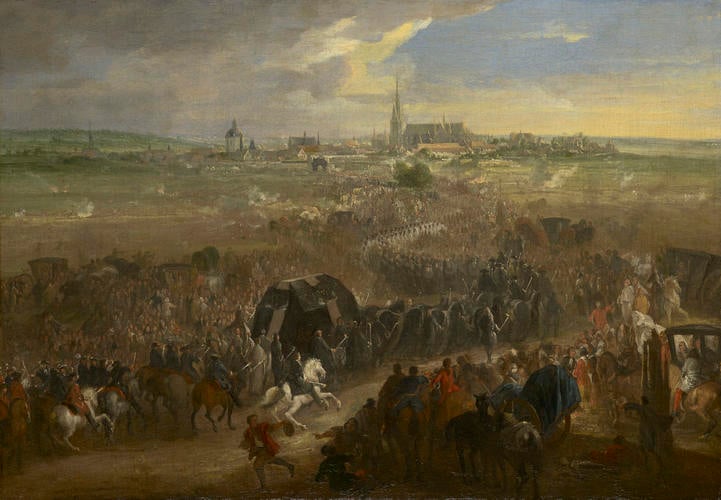The Funeral of Marie Therese, Queen of France, 10 August 1683 1683-90
Oil on canvas | 61.7 x 94.9 cm (support, canvas/panel/stretcher external) | RCIN 404781
-
Adam-François van der Meulen trained as an artist in his native Brussels, learning the newly-emerging genre of battle painting under the tuition of Pieter Snayers (1592-1666/7). In 1664, having caught the eye of Jean-Baptiste Colbert (1619-1683), van der Meulen was summoned to Paris to enter the service of Louis XIV: he spent the next thirty years documenting the Sun King's military victories, often from the field of battle itself, and usually working in close collaboration with Charles Le Brun (1619-1690).
The prestige of Louis XIV appealed to George IV (as to almost every other monarch during the 18th Century), but also meant that van der Meulen’s compositions were widely copied. Of the eighteen ‘Van der Meulens’ acquired by George IV (RCINs 404781, 406554, 406956, 403007, 404699-701, 405027, 405056-7, 405172, 405220, 406377, 406465, 406918, 406955 & 406957-8), this is one of only three (the first listed above) to retain their original attribution.
At the French court, Van der Meulen's approach fused a Flemish-inspired approach to landscape and colour with aerial perspectives, contemporary dress and superficial topographical accuracy, bringing brilliance and interest to what was essentially a reportage and propagandist role. All are in evidence in this painting of the funeral of Maria-Theresa of Spain, first wife of Louis XIV.
The Queen's funeral cortege, drawn by a group of black horses and accompanied by members of the clergy, dominates the foreground and, by a trick of perspective, appears larger than the medieval basilica of St Denis, visible to the right of the typically high horizon line. This gothic church, today housing the remains of all but three Kings of France, is the final destination both of the coffin itself and the solemnly snaking procession that accompanies it. Meanwhile, the countryside surrounding the precise, topographical vision of Paris – with its Breughelian greens, blues and yellows – contrasts with the grave reds and blacks of the figures in the foreground.
This painting was purchased by George IV, when Prince of Wales, in 1799, from the painter and collector Richard Cosway (1742-1821), who believed it to depict the funeral of Marshal Turenne (Henri de la Tour d'Auvergne (1611-1675)). George IV bought almost all of the works attributed to van der Meulen now in the Royal Collection, but he frequently bought them in bulk and evidently viewed them as small-scale court documentary painting, rather than 'great art'. This example was kept in store and later hung alongside portraits of horses in the ornamental cottage retreat of the King's Lodge (now Royal Lodge) in Windsor Great Park. In the twentieth century, the painting's attribution to van der Meulen was questioned, and it was associated instead with van der Meulen's pupil, Pierre-Denis Martin (1663-1742); the subject was identified as the 1715 funeral of Louis XIV himself. However, recent research work now makes an identification with the interment of Marie-Therese more likely, which would conclusively discount the association with Martin and confirm the attribution to Van der Meulen.
Marie-Therese of Spain and Austria (1638-1683) was the daughter of Philip IV of Spain (1605-1665) and Elisabeth of France (1602-1644), the great patrons of the Spanish painter Diego Velazquez. She was for a time heiress presumptive to the entire Spanish Hapsburg Empire, though eventually replaced in the line of succession by her younger brother Charles, later Charles II of Spain (1661-1700). Marie-Therese married her cousin, Louis XIV of France, in 1660, and the following year gave birth to a Grand Dauphin, Louis, who would become the only one of the couple's children to survive infancy. Though she found a close friend at court in the shape of her aunt, the dowager Queen Anne of Austria (1601-1666), Marie-Therese lacked the brilliance and vivacity Louis XIV admired in his mistresses, and her husband, though meticulously courteous towards her, never returned the lifelong devotion she felt for him. Her sudden death at the age of forty-five was a shock to the court, and accelerated the rise at court of Louis' last major mistress, Françoise d'Aubigné, Marquise de Maintenon (1635-1719), later the king's unacknowledged second wife.Provenance
Richard Cosway; from whom bought by George IV for 15 guineas in 1799 recorded at Warwick House in 1816 (no 502) and 1819 (no 544, valued at 50 guineas); sent to the King's Lodge in Windsor Park in 1822
-
Creator(s)
(nationality)Acquirer(s)
-
Medium and techniques
Oil on canvas
Measurements
61.7 x 94.9 cm (support, canvas/panel/stretcher external)
95.5 x 120.1 x 10.6 cm (frame, external)
Alternative title(s)
The Funeral Cortège of Louis XIV (1643-1715) in front of St. Denis, 9 September 1715
The Funeral of Louis XIV (1643-1715)
The Funeral of Henri de La Tour d'Auvergne, Vicomte de Turenne (1611-75), previously identified as
The Funeral of Louis XIV (1643-1715) at St. Denis, 9 September 1715








